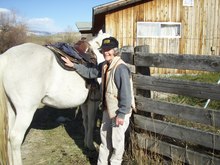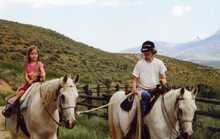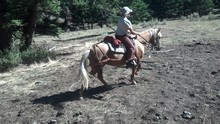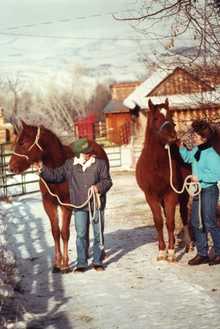Every horse is different, not only in structure and physical characteristics but also in personality. Just like humans, some horses are timid, or hyper and nervous, while others are bold, laid back or aggressive. Working with some of them can be a challenge, to overcome the extremes in their mental makeup.
The important thing is to gain good rapport and a solid bond with the individual horse so your relationship is built on mutual trust and respect. With a timid horse you need to be supportive, and encouraging. You must become the person he can have confidence in when he’s scared or insecure. The last thing you want to do is intimidate this type of horse with aggressive action or forceful reprimands or he may never trust you.

Author Heather Smith Thomas ready to ride with Rubbie
With a timid horse you need to be supportive, and encouraging, while the pushy horse needs a firmer hand and consistent reminders of the rules he must follow.
© 2015 by Andrea Daine
On the flip side is the aggressive horse or the one that is always trying to see if he can get the best of you. He wants to be the dominant member of the team. The pushy horse needs a firmer hand, and consistent reminders of the rules he must follow. He can’t be allowed to push into your space or treat you like a herdmate to roughhouse with.
Working with horses is like dancing, being in tune with your partner, and every horse “dances” a bit differently.
One of the geldings I raised—now 29 years old—is a hyper individual with a very active imagination, always fussing and busy. He trusted me and wasn’t afraid because I’d handled him from the time he was a baby, but he became very bold as a yearling. He continually challenged me whenever I worked with him.
He lived in a pen by himself and his only entertainment was our training sessions in ground work. He tried to vent all that pent-up energy and enthusiasm playing games like nipping and trying to get the upper hand. I wasn’t making much progress on his manners lessons!
I didn’t have a group of young horses for him to live with—which would have been a healthier and more natural situation for him--so I put him in with a 13-year-old gelding. The older horse didn’t like being pestered by the bratty youngster and quickly taught him some respect.

Granddaughter Dani riding Veg - once a bratty youngster
The author riding Rub and leading Veg, the gelding who became a good ranch horse and later a great kid horse, with her granddaughter learning to ride on him.
© 2015 by Lynn Thomas
Living with the older gelding that winter did more for that young one (and a lot easier!) than I could teach him; he learned that he wasn’t the boss and had to submit to the dominant older horse.
When I started working with him again the next spring he was much more ready to behave and pay attention to me. He became a good ranch horse and is now a very mellow old fellow, completely trustworthy, and 4 of my grandchildren have learned to ride on him.
By contrast, a 2-year-old filly I bought 3 years ago was a different challenge. Even though Dottie was friendly, she was hyper and scared. She was halter broke and had been saddled, but not yet ridden. Something in her early handling may have damaged her trust; any quick movement or even a raise of your arm sent her whirling away.
It took a lot of patient, repetitious work to make Dottie realize that no one was going to hurt her. Even now, her 3rd season of being ridden, she still tends to be very reactive, so we keep working on desensitization and building trust. A horse that is reacting in fear should never be punished for his/her actions or this can destroy all the ground you’ve gained.

Gaining Dottie's trust
Dottie & me in Baker Creek during my first summer of training Dottie to ride... she’s wearing a breeching to keep the saddle from sliding too far forward going downhill.
© 2015 by Andrea Daine
Another example of differences in personality (necessitating different handling/training tactics) were three foals we raised, born in 1990, all sired by the same stallion. These were our Muppets; we named them Kermit, Fozzy and Miss Piggy.
Kermit was a “people horse”—always friendly and eager to be with people. His early handling and training went smoothly because he wanted to please us. People were his buddies and his security. His biggest fault was insecurity; he needed a lot of reassurance after we started riding out in the big wide world.
His half-siblings were more challenging. Fozzy was very independent, and not afraid of anything, but it also took more effort to bond with him and create a team. He was my daughter’s horse, and she spent a lot of time leading him out over the hills before she started riding him, and she was the only person he totally trusted.
Miss Piggy was the most independent of all; she didn’t want anything to do with people. Even though we handled her from the time she was born, she didn’t want to be caught. I kept her and her mom in a pen and caught her every day, using mom as an ally; I tied the mare to the fence near a corner, and gently herded the filly into the corner next to her mom, where I could slip a halter on her.

Fozzy and Kermit with Heather and daughter Andrea
Our Muppets: Kermet, Fozzy and Miss Piggy are another example of differences in personality necessitating different handling/training tactics.
© 2015 by Lynn Thomas
Fozzy and Kermit lived together in a large paddock during their early years, from the time they were weanlings, but Miss Piggy had to stay in a small pen after weaning because she was still uncatchable without being cornered!
So for her I did something I never recommend; I left a halter on her, dragging a halter rope. That way, in the small pen, I could quietly get close enough to grab the rope without her running off. I caught her every day, hoping to make her realize that it was no big deal and just part of the daily routine.
Eventually she resigned herself to letting me get closer and closer to get hold of the rope, because she knew it was pointless to try to run away in the small pen. Finally she no longer needed the trailing rope, and eventually she no longer needed the halter.
She was just as stubborn about learning how to tie. I always start with the rope just looped around a post or pole so I can let out slack if needed, with some give-and-take so the foal can’t hurt itself. After these initial sessions I started tying Miss Piggy alongside her mama when she was a foal, but she always set back. I continued her tying lessons though the weanling/yearling stage, tying her up nearly every day and sometimes twice a day, and she finally resigned herself to being restrained by halter and rope.
By contrast I’ve raised a lot of foals that were very easy to halter train for tying, simply looping the tie rope around a post and holding onto the far end of it a little distance away, to give them a bit of slack if necessary. After doing this just a few times, they were content to stand tied, unlike Miss Piggy who stubbornly resisted being tied.
Every horse is different. You feel your way along with each one to find the best way to train and handle them, for optimum success and teamwork. There is no substitute for time spent with the horse, getting to know that horse’s mind, being able to “read” his/her attitude.
Remember this
Working with horses is like dancing, being in tune with your partner, and every horse “dances” a bit differently.
